- Walking the Ancient Ruins of Nicaea (Iznik, Türkiye)
- Discovering the North Gate Basilica in Iznik – Nicaea
- Wow! I found a Nicaea Basilica among the Ruins
- The Ancient Nicaea Walls Today speak History
- Finding the 20 Byzantine Churches and Chapels of Nicaea
- Byzantine History found in the Iznik Museums
- Overview of the Sunken Basilica in Iznik
- Investigating the Frescoes at the Hagia Sophia in Iznik
- Did the Green Mosque Complex Occupy a Nicene Monastery?
- The Rest of the Story of the Nicene Church
In 1391, the Yeşil Camii in Iznik (Green Mosque) was constructed, marking one of the earliest Ottoman structures that combines Seljuk and Ottoman influences. The building took seven years to complete and re-purposed a Byzantine monastery site—the area hints of a few Byzantine spolia. Let’s take a look.
My Suspicion
On my brief walk through this complex, the area gave me a sense of multiple religious layers. The pillars and how the area was set up gave me a hint that something was here before. History ignores what was in this area before the 14th century, but we know that under the surface remain multiple unsearched areas. Let’s explore what is above to gain insight into what was before.
Key Byzantine Spolia
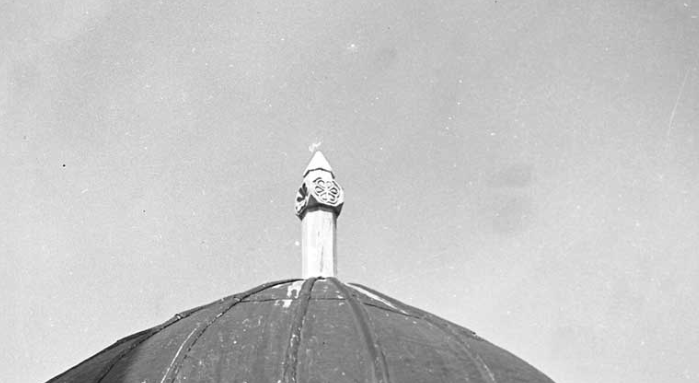
In a 1938 picture of the top of the dome, evidence of Byzantine spolia from the former building in the area is visible. Possibly, the 1956 and 1969 renovations replaced this feature; I overlooked this aspect during my visit.[1]Octagonal drum of the fluted dome seen from outside. Photograph taken in 1938 or earlier. From Ülgen (1938: R:24). Screenshot from: https://journal.eahn.org/article/id/8270/ Scholars state that the Green Mosque begins a truly Ottoman look, but some elements most likely came from a former church in the area.
Inside the Yeşil Camii, a porphyry pillar features Byzantine spolia, alongside the intricate marble-cutting designs found within the mosque. While these marble cuttings may originate from a previous building, the early Ottomans were also adept at creating detailed marble designs that bear a striking resemblance to those in the Hagia Sophia. Both the Seljuks and the early Ottomans incorporated spolia into their mosques, making use of existing materials.
Each nearby building has elements that hint at the use of pillars, capitals, and decorative frames from former Byzantine buildings. On the east side of the mosque, two window frames feature a design that stands out from the building’s other stunning marble patterns. The window frames caught my attention as I walked by, adorned with lotuses and palmettos, reflecting a Roman influence. Could these frames have originated from a previous structure?
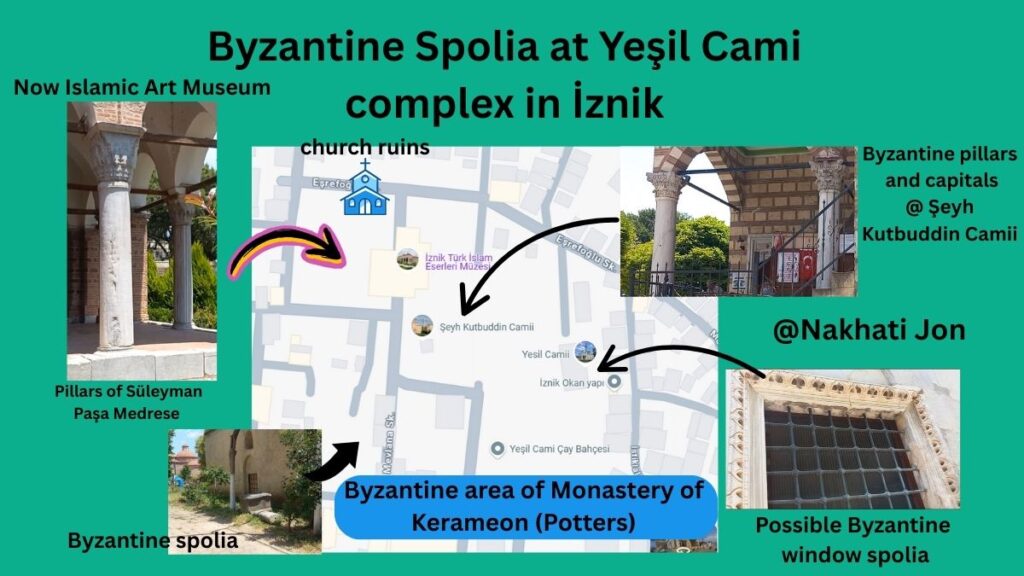
The nearby religious buildings provide some other possible Byzantine elements.




Uniqueness of the Area
Of interest is the article online that discusses this area. The author questions why many buildings near Yeşil Camii in Iznik are below the average Ottoman period level, as if they dug down to the Byzantine level. Additionally, the author laments that weak archaeology has occurred in the area, while treasure hunters have damaged much of what could have been discovered. Here is a screenshot of Historical Heritage in İznik and Basic Principles to Sustain It by Füsun Alioğlu.
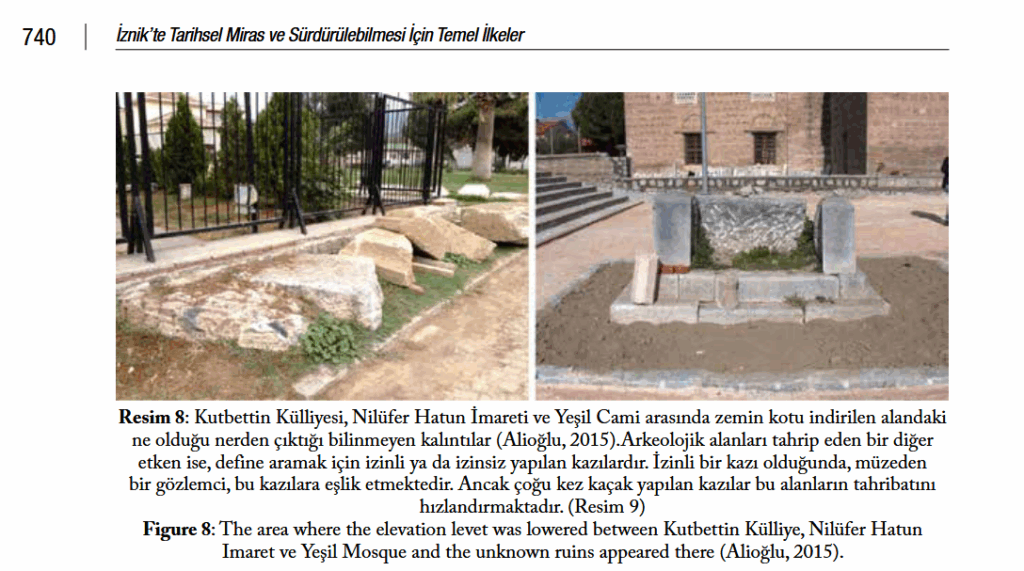
The Christian community faced multiple struggles for survival in Nicaea. In 1065, a major earthquake destroyed most of the buildings. The Seljuks eventually controlled the city until it was besieged by Crusaders in 1197, resulting in its conquest. Before the Ottoman takeover, the city experienced a 30-year blockade from 1301 to 1331, with the last three years marked by battles that left the city in ruins. When the Ottomans entered the area, they took control of the town’s center, particularly the eastern section.
Monastic Focus on Non-worldly Affairs
Monasteries focused on divine issues rather than political ones. A key philosophy of monasteries was that the State occupies worldly affairs and the monastery focused on divine encounters.[2]https://journals.sagepub.com/doi/10.1177/09539468241257767 During the 30-year blockade of Nicaea (before the 1331 take over), this would lead to a slow migration of the Christian community toward Constantinople. Near this mosque, a former monastery existed, known for its pottery ceramics.
A key philosophy during that time could be as Vassilios Paipais said concerning the orthodox idea about sainthood, “This explains why Orthodoxy has not canonised saints simply on account of military prowess or treated soldiers as martyrs, even if they died in defence of the faith or of an Orthodox nation. St Basil’s 13th Canon and Patriarch Polyeuktos’s tenth-century rejection of the canonisation of Byzantine soldiers who died serving the empire illustrate this attitude that reflects Orthodoxy’s reluctance to link holiness to the defence of earthly political purposes or invest political causes with the aura of sanctity.” Therefore, those in the monastery focused on prayer and their gardens, avoiding involvement in political matters.
Those living in monasteries usually fled when war broke out, seeking to escape due to blockades and the looming threat of takeover. For example, when the Ottomans captured Nicaea in 1331, the land and buildings fell into such disrepair that only minimal re-purposing occurred. The Ottomans, instead, established a new community in Nicaea and, as a result, incorporated some unique architectural features into Ottoman thought.
Re-Purposing Christian Locations
Of course, the Hagia Sophia in Iznik served as a mosque after its repurposing. During other 14th-century Seljuk and Ottoman occupations of cities, builders typically included the construction of a mosque complex to accommodate the new Muslim population.
In Antalya (Yivli Minare Mosque), Bursa (Fatih Mosque), and soon to be Istanbul, the first item of business was to take over the Christian site where they could center their presence.
Çandarlı Kara Halil Hayreddin Pasha (1364-1387 – time of reign) commissioned the mosque. He, as a Sufi, was part of the religious ulema (Islamic scholars), desiring to expand the Islamic faith. Occupying a Christian monastery would be ideal. The name of the mosque is Yeşil Cami. In Turkish, the word “cami” refers to a complex (külliye) that typically includes a mosque, a madrasa, a soup kitchen, and often a graveyard. These complexes enhanced social and religious interactions.
Hacı bin Musa built the mosque and it is one of the first named architects to be named as an Ottoman builder. His only other architectural work was the Murad Hüdavendigar (Çankırıkapı) bridge near Ankara (Sönmez 1989). He may have died soon after or around 1391. The building features unfinished stone carvings on its north side, which many associate with the health and impending death of the sultan; however, there could be other reasons behind this dynamic.
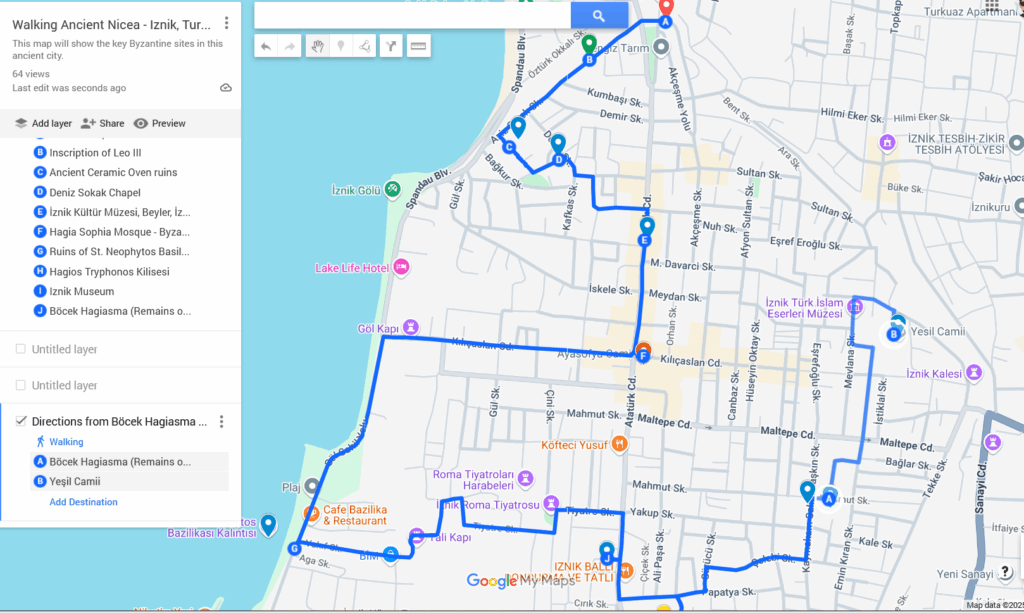
Searching Below the Surface often provides unexpected insights. In archaeology and religion, discerning individuals will take a closer look.
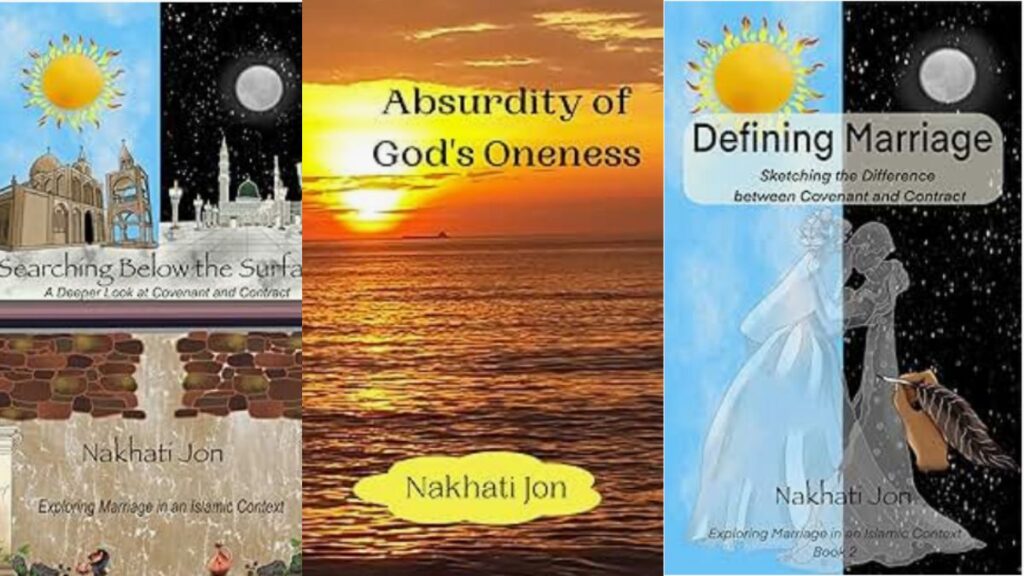
Leave a Reply